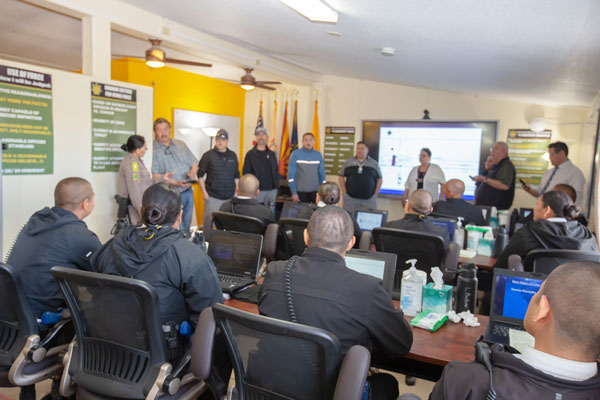
Leaders from the Prince Albert Grand Council (PAGC) and its member nations recently concluded a two-day visit with the Navajo Tribal Police in Chinle, Arizona.
The goal of the visit was to learn about the policing model used by the Navajo Tribal Police, which is based on best practices of Indigenous sovereignty and policing.
“This visit was an important opportunity for us to learn from the Navajo Tribal Police, who have a wealth of knowledge and experience in Indigenous policing,” PAGC Vice-Chief Joseph Tsannie said. “We are excited to bring back the knowledge and insights we gain from this visit to share with our communities as we work to develop our own policing systems and uphold our Treaty and Inherent Rights.”
Tsannie and other leaders made the visit following a recommendation from the PAGC’s 2019 First Nations Policing and Indigenous Justice Symposium, which was held to discuss solutions to challenges faced by PAGC’s member nations in northern Saskatchewan.
“In order to create our own effective policing services, we engaged in a tripartite agreement with the federal and provincial government using the federal First Nations and Inuit Policing Program,” Tsannie said. “As part of our larger effort to investigate the most successful approaches to First Nations policing and justice, we paid a visit to the Navajo Tribal Police. Our goal is to provide member nations with examples and ideas during the consultation phase of the feasibility study.”
During the visit, PAGC leaders and technicians met with Navajo Tribal Police leaders, discussed various policing topics and toured the Navajo Police Department, Navajo Department of Corrections, Navajo Judicial District court, and the Navajo Police Training Academy.
The Navajo Nation’s police force is the largest among more than 200 tribal police forces in the United States, and is the only one that trains its own officers. The visit afforded PAGC leaders the opportunity to learn firsthand about the social, cultural, and historical context of policing in the Navajo Nation, which is located within a 27,000-square-mile reservation, comprised of over 400,000 members, and represents the largest Native American tribe in the United States.
Navajo Tribal Police spokesperson Daryl Noon said the visit was mutually beneficial, as it gave them a change to share their knowledge and experience with other Indigenous communities.
“It was an honour to meet with the PAGC leaders and to reacquaint with our distant Dene relatives of whom we refer to as ‘the Other Entity’ in our Navajo language. Since the late 1800s, we have established our own policing system, and we have experienced the unique challenges that come with it. We are proud to serve our community, and help other Indigenous communities develop their own policing systems.”
In October 2022, PAGC signed a contribution agreement with both the provincial and federal government at its annual assembly to explore new, community-oriented ways to deliver police services and improve safety in First Nations communities. This led to the establishment of a Public Safety Implementation Team (PSIT), which will be responsible for overseeing the feasibility study of the work plan.
The plan will outline the community engagement process, which will assess the 28 First Nations’ interest in self-administered policing. The process is scheduled to commence on May 1st, 2023, and is expected to take up to two years for its final report.
editorial@paherald.sk.ca

